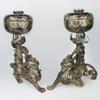Review of Flint Trip
- November 26, 2016 15:45
We’re just back from the Print Fair at the Flint Institute of Arts. Our thanks to all who made it a success, especially curator Tracee Glab, director John B. Henry, and registrar and resident problem-solver Peter Ott, and including museum guards, front desk, gift shop, and café staff as well.
Flint is a fascinating and charming city on the nineteenth century Saginaw Trail, on the Flint River, about 65 miles northwest of Detroit. Beginning with fur trading in 1819, then lumber production, Flint became “Vehicle City” through the making of carriages. In 1908 General Motors was formed in here; the town was the site of an important sit-down strike in 1936-37, leading to the organization of the United Auto Workers. GM’s Buick and Chevrolet divisions were begun in Flint. The jobs provided by these car and truck industries helped make Flint a beneficiary of the Great Migration and a racially diverse city.
The auto industry re-organized, closed. and even demolished some plants, or re-tooled in the late 1980s. There is still substantial automotive production, but at a fraction of the 1950s and 60s. Meanwhile, a thriving arts corridor, the five universities and colleges, and medical facilities have helped fill some of these employer roles.
The housing dates mostly from the 1920s with additions in the 1950s and 60s. We visited several different neighborhoods and found a mix of housing styles and sizes, in what seem like over-sized lots, that is enormously attractive. Further there are frequent parkways in wide streets, mature trees and plantings, and particularly impressive in many areas, extremely large verges between the sidewalks and curbs. There is a sense of light and space that, to me at least, is special to the mid-West and definitely something to be appreciated. The loss of jobs and population in the 1980s and 90s, caused home prices to fall making for some fantastic opportunities to acquire substantial houses at bargain rates. Those days may be over however as recently both the prices and the population have stabilized and started to rebound.
Downtown Flint, primarily Saginaw Street, has some fabulous buildings, especially the lovingly maintained Paterson Building named for automotive pioneer William A. Paterson. The Capitol Theatre, a 1928 extravaganza on East 2nd Street, is undergoing extensive renovation.
The Flint Institute of Art is the second largest art museum in Michigan with an ambitious exhibition, film, and program schedule. It’s on Kearsley Street, a cultural boulevard anchored at the north end by Applewood (historic mansion and farm of the Mott Family), the Flint Institute of Music (home to the Flint Symphony Orchestra and School of Performing Arts), the Flint Youth Theatre, the Longway Planetarium (largest in the state and especially beautiful at night), the Sloan Museum featuring history and technology, the Whiting -- a 2000 seat professional performing arts venue, and the Flint Public Library.
During the Print Fair, with enviable timing, the Institute’s exhibitions included Tracee Glab’s elegant Drawn to the Figure in the Graphics Gallery (just outside the world’s most picturesque art library) and Pressed for Time: History of Printmaking, in the Hodge Exhibitions Galleries. Not only did this show include masterpieces ranging from Durer to Lautrec to Hayter, but even me -- director John Henry kindly pointed out that the video documentary “About Prints” was technically part of the exhibition.
From the Bray Renaissance Gallery with the Rinaldo and Armida seventeenth century French tapestries, to the Art of Jade exhibition featuring both ancient Mesoamerican artifacts as well as Neolithic and Qing Dynasty Chinese pieces, to the excitement of visiting school children and Dale Chihuly’s stunning Persian chandelier at the entrance, the Flint Institute is a wonder. It was a privilege to be there.




__2270x400_c.jpg)















100x100_c.jpg)